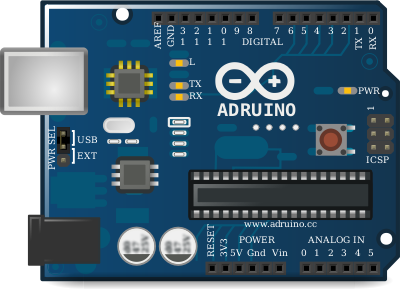There are very many cool Arduino projects and project sites in Internet (make Google search to see). Here are some interesting links to check out:
Arduino Projects at indestructables
Top 40 Arduino Projects of the Web
Arduino Rising: 10 Amazing Projects People Are Doing With The Tiny Microcontroller
Electronics For The Everyman: 25 Kick Ass Arduino-Powered Projects
10 Simple-But-Fun Projects to Make With Arduino
Internet of Thing with Arduino
11 Arduino projects that require major hacking skills—or a bit of insanity
I will be posting more links to more interesting projects as comments to this post, like I did in my Cool uses for the Raspberry Pi posting. Some of the most interesting that spend some more time at can get their entire own postings this blog in Arduino section.

3,022 Comments
Tomi Engdahl says:
https://hackaday.com/2024/11/30/arduino-vga-the-old-fashioned-way/
Tomi Engdahl says:
https://hackaday.com/2024/12/16/using-a-smartphone-as-a-touchscreen-for-arduino/
Tomi Engdahl says:
https://www.xda-developers.com/fun-projects-arduino-pc/
Tomi Engdahl says:
Use old DB15 game port joysticks on USB with this adapter #Retrocomputing #VintageComputing @necro_ware
https://blog.adafruit.com/2022/06/21/use-old-db15-game-port-joysticks-on-usb-with-this-adapter-retrocomputing-vintagecomputing-necro_ware/
Tomi Engdahl says:
https://www.edn.com/a-beginners-guide-to-power-of-iq-data-and-beauty-of-negative-frequencies-part-2/
Tomi Engdahl says:
Give your Arduino project a chatGPT AI brain – for ALMOST free
https://www.youtube.com/watch?v=dv9cyqVv0CI
Tomi Engdahl says:
From Ideas to Code: Enhancing Arduino Programming with chatGPT!
https://www.youtube.com/watch?v=S6ClV3dWiT4&t=28s
Tomi Engdahl says:
https://hackaday.com/2025/02/16/piano-gets-an-arduino-implant/
Tomi Engdahl says:
James Cox’s DIGIduino Is a 3D-Printable, Arduino-Compatible, Microchip ATmega328P-Powered Wristwatch
With a Microchip ATmega328P and a real-time clock, this watch ticks the time away on seven-segment LEDs — or runs your own sketch.
https://www.hackster.io/news/james-cox-s-digiduino-is-a-3d-printable-arduino-compatible-microchip-atmega328p-powered-wristwatch-360c3b0ec0d5
Tomi Engdahl says:
https://hackaday.com/2025/03/09/taming-the-wobble-an-arduino-self-balancing-bot/
Tomi Engdahl says:
https://hackaday.com/2025/03/09/clock-mechanism-goes-crazy-for-arduino/
Tomi Engdahl says:
https://hackaday.io/project/175432-7-segment-2-digit-led-display-board
Tomi Engdahl says:
Ready for efficiency? The new Cloud Editor is coming with a revamped interface, faster speeds, and improved code completion.
Opt in for early access and be ahead in the game! https://blog.arduino.cc/2024/01/17/your-classic-arduino-ide-experience-now-in-the-cloud/
Tomi Engdahl says:
Miniphonic: An Arduino-Based Audio Synthesis Platform
https://www.elektormagazine.com/articles/miniphonic-arduino-based-audio-synthesis-platform-1
In this project, we use an Arduino Uno R4 board and other hardware to make a versatile and performing sound synthesizer and MIDI sequencer. In the first part of this series on audio synthesis, we describe the block diagram and the main functions of the Basic Synth software.
#arduino #audio #diyelectronics
Tomi Engdahl says:
https://github.com/DynamicPerception/DollyShield
Tomi Engdahl says:
Tuossapa aloittelevalle arduino- tai raspberry-rakentelijalle erinomainen opinahjo:
https://m.youtube.com/@paulmcwhorter/playlists
Tomi Engdahl says:
https://hackaday.com/2025/04/07/tracking-the-iss-made-easy/
https://faridrener.com/2025/04/04/tracking-iss.html
Tomi Engdahl says:
The Mouse Language, Running On Arduino
https://hackaday.com/2025/05/20/the-mouse-language-running-on-arduino/
https://github.com/Svarkovsky/UNO-MOUSE
Tomi Engdahl says:
In case you missed our SPEctacular announcement: the Arduino UNO SPE Shield is the UNO R4′s new best friend for adding advanced connectivity to industrial and IoT projects.
With Single Pair Ethernet, this shield enables high-speed data transmission and power delivery over a single twisted pair cable.
Get yours today: https://store.arduino.cc/products/uno-spe-shield
Tomi Engdahl says:
Created by Redditor ‘almost_budhha,’ VolTrack is an Arduino Cloud-connected voltage monitor for 3S Li-ion / LiPo battery packs: https://www.reddit.com/r/arduino/comments/1lgz1vy/voltrack_my_mini_arduino_iot_cloud_based_3s_liion/